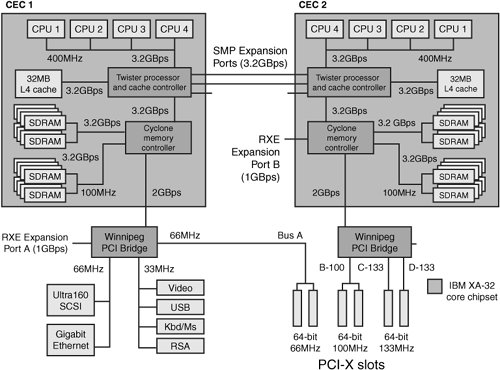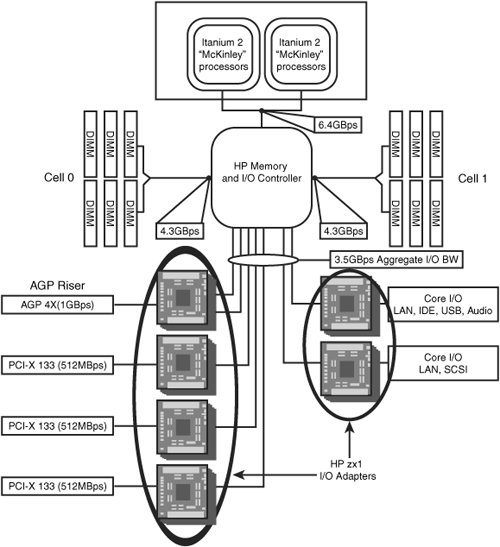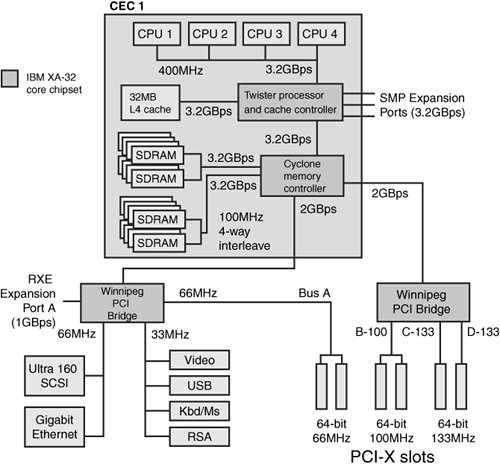Other Third-Party Server Chipsets for Intel Processors
| Although Intel and ServerWorks are the major producers of server-class chipsets for Intel server processors, they are not the only producers of these chipsets. Other vendors, including VIA Technologies, IBM, and Hewlett-Packard have also produced server-class chipsets for Intel processors from the Pentium Pro and Pentium II through the Itanium 2. The following sections discuss the offerings from these companies. VIA Technologies Chipsets for Intel Server ProcessorsAlthough VIA Technologies built a variety of chipsets for the P6 family of processors, only the following have been used in one-way and two-way servers:
Table 3.19 provides an overview of these chipsets.
Although some of VIA Technologies Pentium 4class chipsets are also compatible with the Xeon, litigation has discouraged motherboard makers from adopting them for server-class motherboards. The VIA Technologies Apollo Pro 133A ChipsetThe VIA Apollo Pro133A chipset was a North Bridge/South Bridge chipset designed to support Slot 1 and Socket 370 processors such as the Intel Pentium III, Intel Celeron, and VIA Cyrix III. The Apollo Pro133A is based on the previous Pro133, with additional features added. Note that there are actually two versions of this chipset. The original version was released in fall 1999 and supported single-processor installations and used the VIA 694 North Bridge. In spring 2000, VIA Technologies developed a dual-processorcompatible version using the 694MP North Bridge. Features of the Apollo Pro133A include the following:
The VIA Apollo Pro133A chipset was a two-chip set consisting of the VT82C694X North Bridge controller (single-CPU version) or VT82C694MP North Bridge controller (dual-CPU version) and a choice of a VT82C596B or VT82C686A South Bridge controller. Table 3.20 provides an overview of the features of the South Bridge chips used in the Apollo Pro 133A chipset.
A number of vendors produced dual-processor server motherboards using the Apollo Pro 133A chipset. The VIA Technologies Apollo Pro266 ChipsetThe VIA Apollo Pro266 is a high-performance North Bridge/South Bridge chipset designed to support Socket 370 processors, including the Pentium III. The Apollo Pro266 was the first chipset from VIA to replace the traditional PCI (133MBps) connection between North Bridge and South Bridge chips with VIA's 4x V-Link interconnect, which runs at 266MBps. The Apollo Pro 266 was introduced in late 2000. Features of the Apollo Pro266 include the following:
The VIA Apollo Pro266 chipset was a two-chip set consisting of the 552-pin BGA VT8633 North Bridge controller and the 376-pin BGA VT8233 South Bridge controller. The Apollo Pro266T is an updated version of this chipset that supports Pentium III Tualatin processors. Figure 3.27 shows the architecture of the Apollo Pro266 chipset. Figure 3.27. Apollo Pro266 chipset architecture. Because of the V-Link high-speed interconnect between the North Bridge and South Bridge, PCI is managed by the South Bridge. This is similar to the way in which Intel Hub Architecture works, and this basic architecture has been followed by all subsequent VIA chipsets that use V-Link architecture. The Apollo Pro 266 and 266T (Tualatin-compatible version) chipsets have been used by a variety of vendors to produce both standard ATX form factor and various types of single-boardcomputer servers using one or two processors. IBM Chipsets for Intel Server-Class ProcessorsIBM has produced several chipsets for its own lines of Intel server-class processors:
The XA-32 Chipset for Xeon MP/DPIBM's XA-32 chipset, codenamed Summit, was first fully implemented in the IBM @server xSeries 440, released in September 2002. This chipset, developed by the IBM Microelectronics Division in Austin, Texas, has the following major features:
The components of the XA-32 chipset include the following:
Figures 3.28 and 3.29 show the major components of the XA-32 chipset in a 4-way (top) and 8-way (bottom) configuration, respectively. Each 8-way configuration is called a node, and two nodes can be connected via the SMP expansion ports to create a 16-way processor complex. Figure 3.28. Four-way configuration using the IBM XA-32 chipset. Figure 3.29. Eight-way configurations using the IBM XA-32 chipset. The XA-32 Second-Generation Chipset for Xeon MP/DPThe second generation of the IBM XA-32 chipset is used in IBM xSeries servers such as the x365, x445, and x455. It has the following major differences from the original XA-32:
The block diagram shown in Figure 3.28 applies to both original and second-generation XA-32based systems. The XA-64 Chipset for Itanium 2The IBM XA-64 chipset, codenamed Summit, was first used in the xSeries 450 server released in mid-2003. It was developed by the IBM Microelectronics Division. It has the following major features:
The components of the XA-64 chipset include the following:
Figure 3.30 shows the major components of the XA-64 chipset in a four-way configuration. Figure 3.30. A typical four-way configuration using the IBM XA-64 chipset. The XA-64e Chipset for 64-Bit Xeon ProcessorsIBM's XA-64e chipset, codenamed Hurricane, is used in Xeon EM64T-compatible IBM @servers such as the xSeries 366. This chipset, developed by the IBM Microelectronics Division in Austin, Texas, has the following major features:
The components of the XA-64e chipset include the following:
Figure 3.31 shows the major components of the XA-64e chipset in a four-way configuration. Hewlett-Packard Server Chipsets for Intel ProcessorsIn addition to using server chipsets from third-party vendors, Hewlett-Packard has developed two distinct lines of chipsets for its servers:
The following sections discuss the major features of these chipsets. The F8 Chipset for Xeon MPThe Hewlett-Packard F8 chipset was developed by Compaq as a follow-on to the eight-way Corollary chipset co-developed by Corollary and Compaq. Hewlett-Packard obtained the F8 chipset as part of its merger with Compaq. The F8 chipset is used in the Hewlett-Packard ProLinea DL740 and DL760-series eight-way servers. The F8 chipset's major features include the following:
The F8 chipset has the following major components:
Figure 3.32 illustrates the major components of the F8 chipset. Figure 3.32. The F8 chipset supports eight-way Xeon MP processors. The zx1 Chipset for Itanium 2 McKinleyThe Hewlett-Packard zx1 Pluto chipset for the Itanium 2 processor uses only two or three chips, making it the simplest chipset available for the Itanium 2 processor. However, although the zx1 is designed to work in one-way and two-way workstation configurations as well as in two-way and four-way server applications, it does not support eight-way implementations. Note The Hewlett-Packard zx1 also supports some PA-RISC processors made by Hewlett-Packard. In fact, some Hewlett-Packard servers can be converted from one processor type to the other. The Hewlett-Packard zx1 chipset has the following components in two-way configurations:
When used in a four-way server implementation, two Hewlett-Packard zx1 scalable memory adapter chips are added to the chipset to connect the greater number of memory banks supported, and additional Hewlett-Packard Chipset I/O adapters are used to support additional 66MHz PCI-X devices. Some of Hewlett-Packard's latest servers based on the zx1 incorporate two Itanium 2 processors in the mx2 dual processor module, enabling the chipset to support eight-way implementations. Figure 3.33 illustrates a typical two-way (workstation/server) implementation of the zx1 chipset, and Figure 3.34 shows a typical four-way server implementation. Figure 3.33. The Hewlett-Packard zx1 chipset, shown here in a two-way configuration, uses two or three chips, depending upon the number of processors supported. Figure 3.34. A four-way configuration of the Hewlett-Packard zx1 chipset. The sx1000 Pinnacles ChipsetThe Hewlett-Packard Super-Scalable Processor chipset sx1000, codenamed Pinnacles, supports eight-way or higher implementations. Like the zx1, it can use single- or dual-processor cartridges. However, compared to other Itanium 2 chipsets, it has several distinct features:
Note Hewlett-Packard uses the term cell to refer to a component that contains processors, control chips, and memory modules in an easily swappable package. The cell architecture design used by servers such as the sx1000 permits the server to be upgraded from a RISC-based processor such as the PA-8700 to the Intel Itanium 2 by swapping cells. Figure 3.35 illustrates the block diagram of a four-way or eight-way sx1000 cell board. A four-way cell board uses four standard Itanium 2 processors, while an eight-way cell board uses four Hewlett-Packard mx2 processor cartridges, each of which contains two Itanium 2 processors along with 32MB L4 memory cache. Figure 3.36 illustrates the block diagram of an mx2 processor cartridge. The sx1000 is designed to be highly scalable to handle server tasks of virtually any size and complexity. |
EAN: 2147483647
Pages: 240




